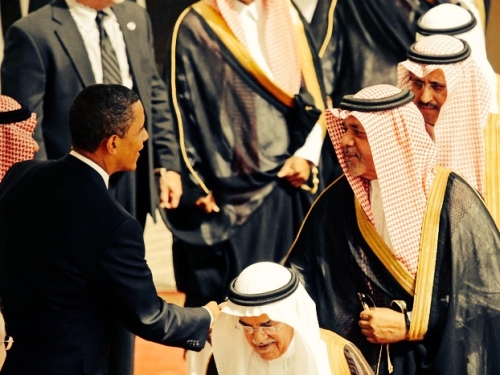by GIORGIO CAFIERO and DANIEL WAGNER
 President Barack Obama and Saudi Arabia’s Prince Muqrin bin Abdulaziz shaking hands. Muqrin was the crown prince but the new Saudi King Salman has removed him from that post. The new crown prince is Interior Minister Mohammed bin Nayef. PHOTO/ISN
President Barack Obama and Saudi Arabia’s Prince Muqrin bin Abdulaziz shaking hands. Muqrin was the crown prince but the new Saudi King Salman has removed him from that post. The new crown prince is Interior Minister Mohammed bin Nayef. PHOTO/ISN
To hear Saudi leaders tell it, the kingdom is under constant threat from Iran. But graver threats of their own making lurk at home
To hear Saudi leaders tell it, the primary threat to the kingdom’s stability is the Islamic Republic of Iran. Worried over Washington and Tehran’s slowly improving relationship, Riyadh has projected an increasingly militarized and sectarian foreign policy aimed at countering Iran’s alleged hegemonic aims in the Middle East.
Yet tension with Iran is only one element of an increasingly complicated mosaic of threats to Saudi Arabia. In fact, the gravest dangers to the kingdom come from within.
Saudi Arabia is a classic rentier state. In exchange for the absolute acquiescence of its 29 million subjects, the ruling al-Saud family provides services such as housing, health care, education, and a variety of subsidies — all funded by the country’s substantial oil wealth. Combined with intolerance for dissent, control over these resources has historically served as the ruling family’s hedge against instability of all varieties.
In 2011, for example, the Saudi leadership responded to the Arab Spring revolts across the region by injecting $130 billion in the form of salary increases, public-sector job creation, and housing subsidies to minimize the potential for an uprising. Meanwhile, the kingdom’s appalling human rights record has deteriorated. Over the past four years, beheadings have skyrocketed and torture has flourished.
However, this authoritarian rentier state model is unsustainable. Oil revenues are down, local unrest is simmering, and extremists are taking aim at the kingdom from without and within. The roots of all these problems come not from Iran but from inside Saudi Arabia itself.
Feeling the Pinch
The global slide in oil prices has taken a toll on Saudi Arabia’s fossil-fueled economy. Foreign reserves dropped by $36 billion this spring, and are projected to fall another $300 billion within two years. The kingdom’s 2015 budget deficit — the first in seven years — is projected to reach $40 billion. With the kingdom waging a costly military campaign in Yemen, and the recently installed King Salman granting salary bonuses to public employees and military families, Saudi Arabia’s coffers are being drained at a rapid pace.
Demographic realities exacerbate these fiscal pressures. Unlike many Arab states that have declining or stable birth rates, Saudi Arabia’s population is growing. More half of the kingdom’s population is under the age of 25 and two-thirds are under 29. With a high youth unemployment rate and an estimated 25 percent of Saudis living in poverty, the economic grievances that drove Arabs in Egypt, Libya, Tunisia, and Syria to revolt could spark similar forms of resistance among Saudi Arabians, constituting a major worry for the royal family.
The kingdom’s educational system is in dire need of reform. While many young Saudis are well-versed in the Koran as a result of their religious education, they often lack skills that are more practical and applicable to the global economy. The human capital of the country’s women is especially underdeveloped. Sixty percent of Saudis enrolled in higher education are women, yet the country’s female unemployment rate is 32.5 percent.
King Salman’s predecessor, King Abdullah, pursued progressive reforms (by Saudi Arabian standards) on gender issues, but the kingdom’s conservative elements prevented much progress. The reality is that Saudi law still recognizes women as property of their male relatives. In Saudi Arabia, which remains the only country that bans female drivers, if a woman falls in public it’s even illegal for an ambulance to pick her up.
Foreign Policy in Focus for more
